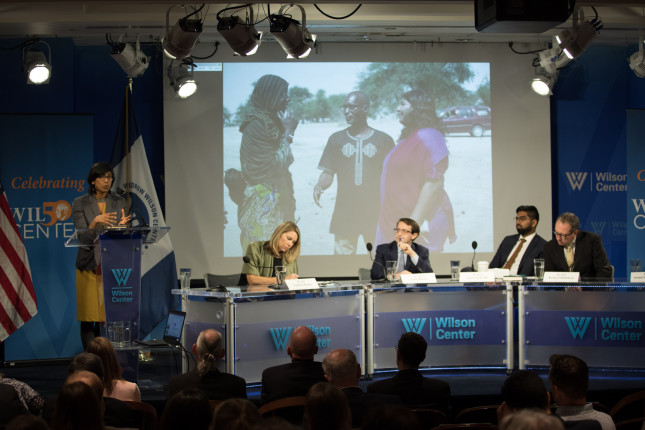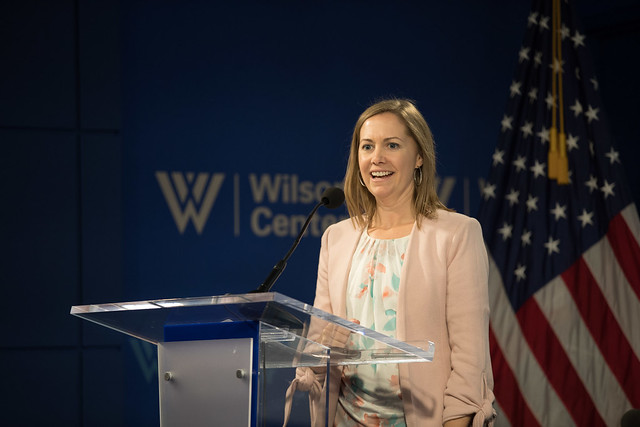-
50 Years of Water at Wilson: Water, Conflict, and Cooperation (Part 1 of 2)

A number of countries across North Africa, the Middle East, into Central and South Asia are “at risk of failure if they can’t get the water equation right,” said Aaron Salzberg of the U.S. Department of State, at a recent Wilson Center event celebrating 50 years of working on water’s connection to conflict and cooperation. The event brought together experts from government, NGOs, and academia for a comprehensive look at the first year of the U.S. Global Water Strategy and new research and practice on water, peace, and conflict. Either now or sometime in the near future, said Salzberg, if fundamentally water insecure countries lacking access to sustainable supplies of safe drinking water and basic sanitation do not address their water problems, they will face increased risk of failure and greater fragility.
“At the core of our contributions to the strategy is strengthening governance and institutions and mobilizing innovative financing to help partner countries provide their citizens with affordable, equitable and sustainable access to safe water and sanitation,” said James Peters, Acting Global Water Coordinator with the U.S. Agency for International Development (USAID).
Sustainable Infrastructure
Many defensive systems, such as dams, are underperforming or failing in the face of flooding and other natural disasters, said John Matthews, Lead and Co-Founder of the Alliance for Global Water Adaptation. “The trouble is, we have a very limited understanding of exactly how near collapse, or breakdown, or failure, much of our infrastructure is,” said Richard Matthew, Director of the Blum Center for Poverty Alleviation at University of California, Irvine.
Part of the problem is that our infrastructure is developed without long-term consideration to sustainability. Instead, said Matthews, projects are driven by a finance period, a political agenda, or private sector interests. Climate change is an opportunity to rethink how we think about sustainability itself.
Improvements in big data management, modeling, and high-resolution mapping tools can facilitate sustainable solutions and boost stakeholder engagement. “To be useful, tools have to provide the right information in the right resolution,” said Matthew. Instead of crude visuals of climate change at a global scale, models can now be built in foot by foot grids, providing powerful and technical visual aids to local communities forecasting and planning for the changing climate and potential humanitarian crises.
Climate-Proofing and Resilient Development
Climate change “will mean more forced displacement and more desperate conditions for displaced people,” said Syed Imran Ali, Fellow in Global Health and Humanitarianism at the Dahdaleh Institute for Global Health Research. Lack of data related to water can lead to a healthcare emergency. Insufficient information about the hydrology at the site of Jamam refugee camp in South Sudan meant the combination of flooding and inaccessible groundwater created a situation where “there was water everywhere but nothing to drink,” from 2012 to 2013, said Ali. The following crisis saw waterborne diseases tear through the camp until water sanitation could be brought under control. Investing in water and sanitation infrastructure in both camps and host communities will create more resilient communities and make it possible to maintain minimum humanitarian standards.
“We need to get the risk assessment right,” said Janani Vivekananda, Senior Advisor for climate change and peacebuilding at adelphi. The UN Security Council recently released a report calling for better risk assessment and management in the Lake Chad region. Some believe the lake is shrinking, so they endorse piping water in. But Vivekananda said the issue is not one of water scarcity, but of variability and uncertainty. The lake has natural periods of expansion and shrinkage and communities have adapted their livelihoods according to those patterns. Unpredictable changes in precipitation patterns have made it difficult for local communities to sustain their livelihoods, especially given the instability and conflict in the region. Improved risk assessment and planning can alleviate the stress on their livelihoods and ensure that “peace is climate-proof,” said Vivekananda.
Conflict and Cooperation
Millions around the world “lack access to a sustainable supply of safe drinking water and to basic sanitation,” which can impede economic development, factor into migration and civil unrest, and “aid in terrorist recruitment,” said Aaron Salzberg. Also, water insecurity could destabilize states and thereby affect U.S. national security interests, he said.
It is a myth that water inherently causes interstate war, said Scott Moore, but it can spark tensions at the subnational level. Countries are prone to disagreement over transboundary water resources, such as the Nile River and the Indus River. Yet, they nonetheless construct shared infrastructure and institutions to ensure that their citizens get enough to drink. In fact, in the best cases, “water is a fantastic tool to build trusting cooperation and to strengthen regional integration,” said Salzberg, noting that it can create ties that will stabilize regions across the world.
Strengthening Governance and Institutions
Effective governance and leadership on water issues moving forward will be foundational to progress. “It’s critically important to have a shared vision and plan for sustainable water resources and management across boundaries,” said Melissa Ho, Vice President of Fresh Water at the World Wildlife Fund. The shared plan must value both nature and people. “It’s not an either or,” she said. “They go together.” Expanding on this idea, John Parker, Deputy Director of the Sustainable Water Partnership at Tetra Tech said, “Progress on transboundary water cooperation requires sustained engagement and partnerships.”
“It is absolutely critical to engage stakeholders at the outset of any process and [to] have them really lead that process” said Parker. Aaron Wolf, Professor of Geography at Oregon State University, explored why certain ideas catch on. “What motivates people to do the things they have done?” he said. “And what motivates people as we move forward?” One tool we have, Wolf said, is the “elaborate” relationship people have with water. We have allies in this drive to shift the way we do things, he said. Wolf pointed to a number of popular water festivals, illustrating better ways of motivating society to care for its water resources by speaking to people on a more visceral level. Similarly Wolf identified the faith community as an ally in water conservation moving forward.
Looking Forward
“When I think about how we’ll manage water differently 30, 40, 50 years from now, I see three big trends coming,” said Ken Conca, Professor of International Affairs for American University in response to the many global needs brought to the fore by earlier speakers. “We will be storing a lot more water, we’ll be recycling a lot more water, and we’ll be thinking much more systematically and foundationally about flood risk.” To achieve this, said Conca, we will have to better manage the “micro-considerations” and more effectively anticipate unintended consequences because for many people, those unintended consequences are the real story.
Sources: Doctors Without Borders, National Geographic, Norwegian Refugee Council, United Nations Security Council
Photo Credit: Wilson Center.
 A Publication of the Stimson Center.
A Publication of the Stimson Center.




